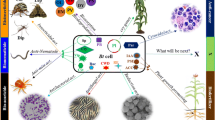Abstract
Bacillus thuringiensis (Bt) has been used as a biopesticide in agriculture, forestry and mosquito control because of its advantages of specific toxicity against target insects, lack of polluting residues and safety to non-target organisms. The insecticidal properties of this bacterium are due to insecticidal proteins produced during sporulation. Despite these ecological benefits, the use of Bt biopesticides has lagged behind the synthetic chemicals. Genetic improvement of Bt natural strains, in particular Bt recombination, offers a promising means of improving efficacy and cost-effectiveness of Bt-based bioinsecticide products to develop new biotechnological applications.



Similar content being viewed by others
References
Baum JA, Gilmer AJ, Mettus A-ML (1999) Multiple roles for TnpI recombinase in regulation of Tn5401 transposition in bacillus thuringiensis. J Bacteriol 181:6271–6277
Couesnon A, Pereira Y, Stiles BG, Popoff MR (2006) Toxin gene regulation. In: Gillet D, Johannes L (eds) Recent research developments in toxins from bacteria and other organisms. Research Signpost, Kerala, India, pp 35–68
Delecluse A, Charles J-F, Klier A, Rapoport G (1991) Deletion by in vivo recombination shows that the 28-kilodalton cytolytic polypeptide from Bacillus thuringiensis subsp. israelensis is not essential for mosquitocidal activity. J Bacteriol 173:3374–3381
Federici BA, Park H-W, Bideshi DK, Wirth MC, Johnson JJ (2003) Recombinant bacteria for mosquito control. J Exp Biol 206:3877–3885
Federici BA, Park H-W, Sakano Y (2006) Insecticidal protein crystals of bacillus thuringiensis. In: Shively JM (ed) Inclusions in prokaryotes. Springer-Verlag, Berlin, Heidelberg, pp 196–236
Furlaneto L, Saridakis H, Arantes OMN (2000) Survival and conjugal transfer between Bacillus thuringiensis strains in aquatic environment. Braz J Microbiol 31:233–238
Kaur S (2000) Molecular approaches towards development of novel Bacillus thuringiensis biopesticides. World J Microbiol Biotechnol 16:781–793
Kaur S (2006) Molecular approaches for identification and construction of novel insecticidal genes for crop protection. World J Microbiol Biotechnol 22:233–253
Lereclus D, Arantes O, Chaufaux J, Lecadet MM (1989) Transformation and expression of a cloned δ-endotoxin gene in Bacillus thuringiensis. FEMS Microbiol Lett 60:211–218
Lereclus D, Vallade M, Chaufaux J, Arantes O, Rambaud S (1992) Expansion of the insecticidal host range of Bacillus thuringiensis by in vivo genetic recombination. Biotechnology l0:418–421
Lereclus D, Agaisse H, Gominet M, Chaufaux J (1995) Overproduction of encapsulated insecticidal crystal proteins in a Bacillus thuringiensis spoOA mutant. Biotechnology 13:67–71
Lertcanawanichakul M, Wiwat C (2000) Improved shuttle vector for expression of chitinase gene in Bacillus thuringiensis. Lett Appl Microbiol 31:123–128
Liu X, Peng D, Luo Y, Ruan L, Yu Z, Sun M (2009) Construction of an Escherichia coli to Bacillus thuringiensis shuttle vector for large DNA fragments. Appl Microbiol Biotechnol 82:765–772
Mesrati LA, Karray MD, Tounsi S, Jaoua S (2005) Construction of a new high-copy number shuttle vector of Bacillus thuringiensis. Lett Appl Microbiol 41:361–366
Pardo-Lopez L, Munoz-Garay C, Porta H, Rodriguez-Almazan C, Soberon M, Bravo A (2009) Strategies to improve the insecticidal activity of Cry toxins from Bacillus thuringiensis. Peptides 30:589–595
Pigott CR, Ellar DJ (2007) Role of receptors in Bacillus thuringiensis crystal toxin activity. Microbiol Mol Biol Rev 71:255–281
Pinnamaneni R, Reddy NS, Rao K, Sambasiva S (2004) Bt gene—an exploratory approach. Asian J Microbiol Biotechnol Environ Exp Sci 6:533–539
Raddadi N, Cherif A, Ouzari H, Marzorati M, Brusetti L, Boudabous A, Daffonchio D (2007) Bacillus thuringiensis beyond insect biocontrol: plant growth promotion and biosafety of polyvalent strains. Ann Microbiol 57:481–494
Roh JY, Choi JY, Li MS, Jin BR, Je YH (2007) Bacillus thuringiensis as a specific, safe, and effective tool for insect pest control. J Microbiol Biotechnol 17:547–559
Sansinenea E, Sanchez P, Anastacio E, Ibarra J, Olmedo G, Vazquez C (2010) Homologous recombination to Bacillus thuringiensis chromosome in one step. Agrociencia 44(4):437–447
Soberon M, Fernandez LE, Perez C, Gill SS, Bravo A (2007) Mode of action of mosquitocidal Bacillus thuringiensis toxins. Toxicon 49:597–600
Soberon M, Gill SS, Bravo A (2009) Signaling versus punching hole: how do Bacillus thuringiensis toxins kill insect midgut cells? Cell Mol Life Sci 66:1337–1349
Tabashnik BE, Gassmann AJ, Crowder DW, Carriere Y (2008) Insect resistance to Bt crops: evidence versus theory. Nat Biotechnol 26:199–202
Thamthiankul S, Moar WJ, Miller ME, Panbangred W (2004) Improving the insecticidal activity of Bacillus thuringiensis subsp. aizawai against Spodoptera exigua by chromosomal expression of a chitinase gene. Appl Microbiol Biotechnol 65:183–192
Vilas Bôas LA, Vilas Bôas GFLT, Saridakis H, Lemos MVF, Lereclus D, Arantes OMN (2000) Survival and conjugation of Bacillus thuringiensis in a soil microcosm. FEMS Microbiol Ecol 31:255–259
Yu J, Zhang Y, Pang Y, Xu M (2000) A replication origin of Bacillus thuringiensis. Curr Microbiol 40:123–127
Yue C, Sun M, Yu Z (2005a) Improved production of insecticidal proteins in Bacillus thuringiensis strains carrying an additional cry1C gene in its chromosome. Biotechnol Bioeng 92:1–7
Yue C, Sun M, Yu Z (2005b) Broadening the insecticidal spectrum of Lepidoptera-specific Bacillus thuringiensis strains by chromosomal integration of cry3A. Biotechnol Bioeng 91:296–303
Zhou Y, Choi Y-L, Sun M, Yu Z (2008) Novel roles of Bacillus thuringiensis to control plant diseases. Appl Microbiol Biotechnol 80:563–572
Acknowledgements
We thank VIEP (project) and CONACyT (project N° 80915) for financial support. We wish to thank Professor Herbert Höpfl (from Morelos State University, UAEM) for critical reading of the manuscript. We want to give a special acknowledgement to the referees who revised the manuscript and made a great effort to improve it.
Author information
Authors and Affiliations
Corresponding author
Rights and permissions
About this article
Cite this article
Sansinenea, E., Vázquez, C. & Ortiz, A. Genetic manipulation in Bacillus thuringiensis for strain improvement. Biotechnol Lett 32, 1549–1557 (2010). https://doi.org/10.1007/s10529-010-0338-1
Received:
Accepted:
Published:
Issue Date:
DOI: https://doi.org/10.1007/s10529-010-0338-1




